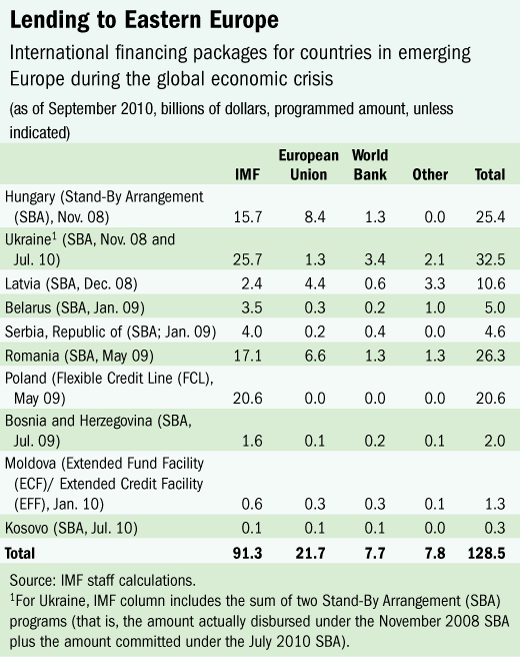
Typical street scene in Santa Ana, El Salvador. (Photo: iStock)
IMF Survey: Worst Outcome Was Avoided in Emerging Europe, New IMF Study Finds
October 20, 2010
- Credit, demand booms driven by capital inflows proved unsustainable
- Emerging Europe avoided currency crises, financial sector meltdowns
- Fiscal policy, prudential measures key to avoiding future boom-bust cycles
Even though emerging Europe was hit exceptionally hard by the global financial crisis, a complete meltdown was avoided thanks to swift action by policymakers, underpinned where necessary by international financing, according to the IMF’s new Regional Economic Outlook report.

Shopping precinct in Szentendre, Hungary: credit boom drove emerging Europe’s growth as global capital poured in (photo David Ryan/Newscom)
REGIONAL ECONOMIC OUTLOOK
Two years after the collapse of Lehman Brothers, the report takes stock of emerging Europe’s experience before, during, and after the global financial crisis. It concludes that credit booms can be very costly: they bring high output volatility that often result in deep recessions, and do not seem to be associated with higher average growth.
Boom driven by large capital inflows
During 1995–2008, emerging Europe enjoyed exceptionally high growth. It was initially driven by the external sector, but from 2003 onwards, a domestic demand and credit boom increasingly took over as capital poured into the increasingly financially integrated region from highly liquid global markets. A large part of these inflows was intermediated by the local affiliates of western banks, which had come to dominate most local banking systems.
The boom years left much of the region addicted to a continuation of foreign-financed credit growth. Large current account deficits, high external debt, and homegrown asset price bubbles all indicated a high level of vulnerability. In Russia and Ukraine, the economies relied on energy and steel exports continuing to fetch favorable prices on global commodity markets.
It is therefore not surprising that emerging Europe was particularly hard hit by the financial turmoil that followed the collapse of Lehman Brothers in September 2008. Although western banks stood by their local affiliates and broadly maintained exposure, the sudden lack of new inflows, together with the freezing-up of the wholesale funding and syndicated loan markets, was a major disruption. The subsequent collapse of global trade and commodity prices compounded the problems.
Avoiding the worst outcome
Policymakers and international financial institutions responded swiftly to the crisis—defusing the risk of full-scale currency crises and financial sector meltdowns. Given the scale of the adverse shocks and the vulnerabilities built up in the boom years, there was no escaping a major setback. However, an even worse outcome was avoided.
Policymakers moved quickly to stabilize their banking systems. Monetary policy was adjusted to either guard against excessive currency depreciation or stimulate domestic demand, depending on country circumstances, and fiscal balances were allowed to deteriorate, with a partial offset from consolidation measures in countries facing fiscal constraints.
Large amounts of external financing were made available by the IMF, the European Union, and other international financial institutions. The Fund provided the overall framework with nine IMF-supported programs in the region. A new Flexible Credit Line arrangement was also extended to Poland (see Table). As a result, a much feared exchange-rate overshooting, which could have deepened the crisis through adverse balance sheet effects, was avoided.

Exchange rate pegs generally held—only Russia and Ukraine saw themselves compelled to allow more exchange rate flexibility, and Belarus devalued. Most countries also managed to steer clear of a banking crisis, except for Latvia and Ukraine.
The crisis experience differed greatly among the countries of the region. While all countries suffered, Poland for example managed to avoid a recession while the Baltic countries and Ukraine saw double digit contractions of economic activity. As the IMF study explains, the size of the pre-crisis credit boom explains these divergent outcomes better than any other variable.
Lessons learned
The study draws several lessons from the boom-bust. Credit booms can be very costly—they bring high output volatility with deep recessions, and seen over a longer time period do not seem to be associated with higher average growth.
Mitigating credit booms through prudential measures is challenging, particularly in countries where the banking system is dominated by affiliates of foreign banks, and requires home-host supervisory cooperation to be effective.
The study also notes that a more active fiscal policy would have helped lessen overheating prior to the global financial crisis. But most countries treated buoyant revenues during the boom years as permanent and stepped up spending correspondingly rather than building fiscal buffers. Tighter fiscal policy would have been particularly helpful in highly financially integrated countries with pegged exchange rate regimes, where credit growth was particularly high and difficult to control because of a limited set of monetary policy tools.
These lessons point to one overarching policy conclusion, the study says: it will be important in the next boom to be skeptical about “this time is different” stories and maintain a cautious macroeconomic policy stance.


